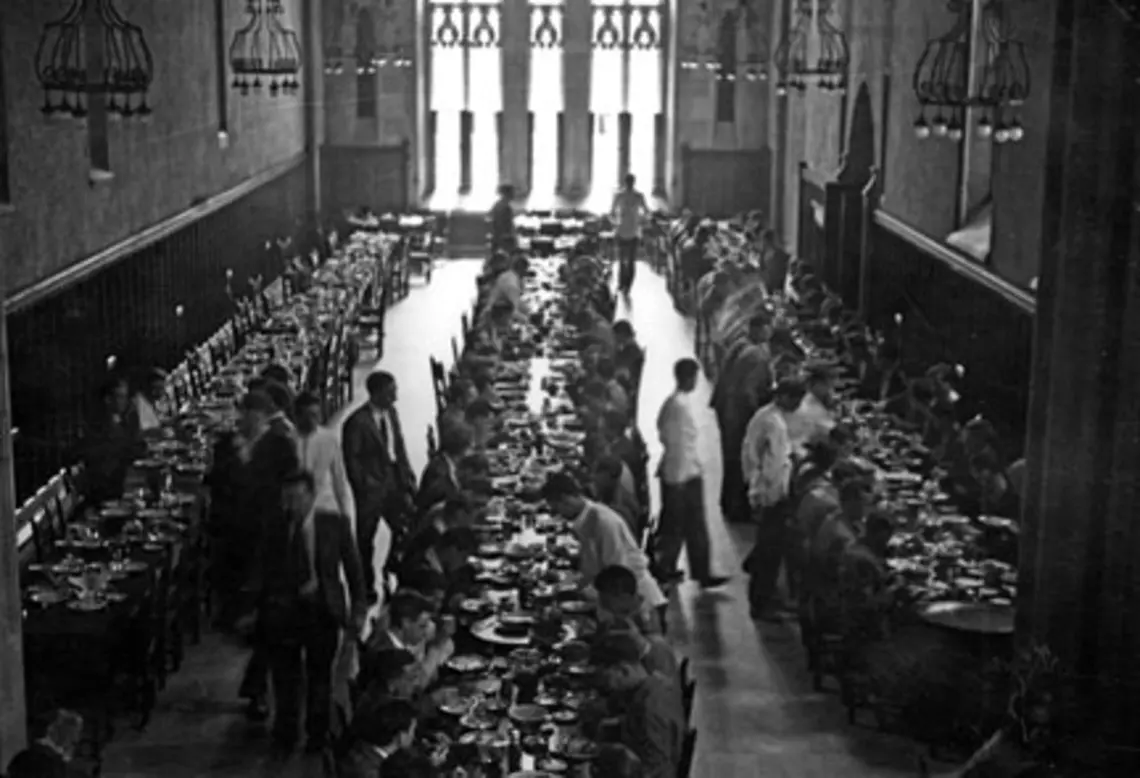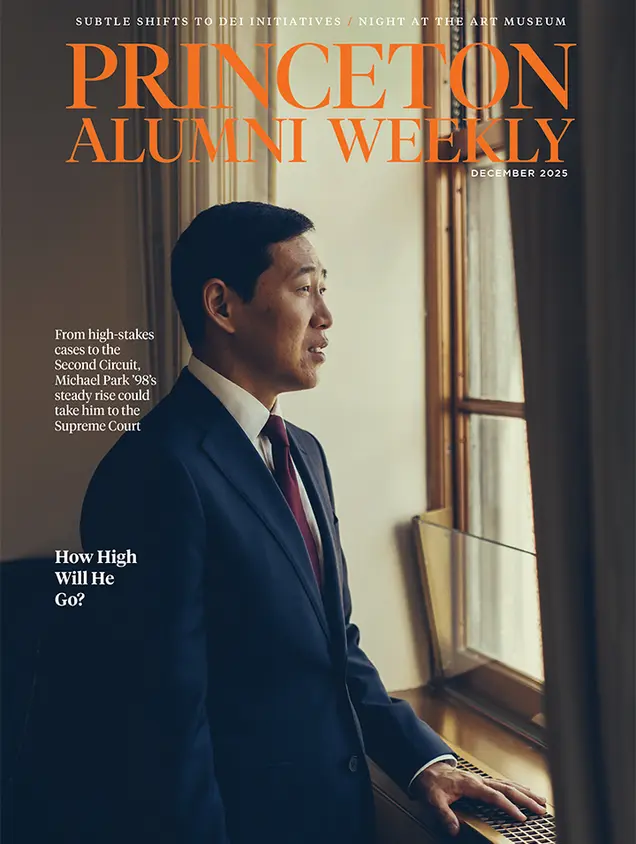
Princeton Statistics in the Era of Big Data; Dining at Commons
Rally ’Round the Cannon Podcast
Remember statistics, the disappearing department? Well, to Gregg’s delight, it is alive, well, and possibly growing. Also, we take a look at meals at Commons, from the days of gray-ish meat and shepherd’s pie. Share your favorite campus dining memories in the comments.
The Rally ’Round the Cannon podcast is also available on iTunes — click here to subscribe
TRANSCRIPT
BT: I’m Brett Tomlinson, the digital editor of the Princeton Alumni Weekly.
GL: And I am Gregg Lange from the great Class of 1970, who should know better.
BT: And welcome again to the Rally ’Round the Cannon podcast, a conversation about Princeton history and the people behind it. Gregg, a few months ago, we spoke a bit about your undergraduate department, statistics, which of course is no longer a department —
GL: Brett loves this, by the way.
BT: I don’t mean to bring it up, I feel for you —
GL: His thesis is they took one look at me and dissolved it. It’s the only department that I know of that’s ever been taken out.
BT: Well you mentioned that it lives on in the Center for Statistics and Machine Learning.
In the April 20 issue, we learn that not only is statistics alive and well at Princeton, but it may indeed be poised for growth in this era of big data, according to one batch of recommendations from the University’s recent strategic planning process. So Gregg, I have to think that this really warms your heart.
GL: Oh absolutely. They’ll be giving people Ph.D.s in data science, or whatever they decide to call it, and have graduate certificates in other departments, which frankly is probably more important because, to some degree, this is sort of like a wolf-in-sheep’s-clothing circumstance because using “big data” as an excuse to formally expand statistics and machine learning is just using current buzzwords, among other things. There are many other aspects, especially the interdepartmental and cross-functional of statistics and increasingly applied computing as well, to all of these things that more than justify the suggestion of what the University’s doing and what is interesting is I would tend to think those suggestions would be supported by at least 15 or 20 different departments where statistics has become, over the years, absolutely crucial to everything from defining interest to even doing all kinds of scientific research.
BT: It’s, at the same time, kind of honoring this great history that goes back to the pre-World War II era, of statistics at Princeton.
GL: If you really want to get down to brass tacks – and it’s funny, in my various columns I often refer to this – it’s just astonishing the number of odd things at Princeton that go directly back to Woodrow Wilson personally. One of the preceptor guys that he hired in 1905 was a mathematician by the name of Oscar Veblen, who was a young guy then (and he is related to Thorstein Veblen, for you history buffs). Oscar Veblen was one of the first applied-mathematician types to practice full time in the U.S. because he was doing essentially what he wanted at Princeton. And he built up, eventually, applied mathematics at Princeton. He was the one who hired Samuel Wilkson in 1933, who was really the first statistics faculty member at Princeton – it was then called mathematical statistics. When he was in the door, he and Veblen and John Von Neumann, who had come over to the Institute for Advanced Study but of course was sitting literally in the next office from them in Fine Hall, got in such students at that point – slackers like Alan Turing *38 and John Tukey *39, who were there almost simultaneously. Turing got his Ph.D. in 1938 – we know about him, for those of you who have seen The Imitation Game. Tukey got his Ph.D. in ’39, became the first head of the statistics department in 1965, and Tukey was working consistently with Von Neumann, who was over at the Institute for Advanced Study and building computers in the same way that Alan Turing had. Beginning at Bletchley Park they were known as Turing Machines because he had theorized them before he came to Princeton.
Oskar Morgenstern, in the mid-’40s, joined with Von Neumann, who in his spare time also was inventing game theory, which was then carried on by John Nash *50, with the Ph.D. dissertation that won his Nobel Prize, with people like Harold Kuhn as well, who I’ve written about before. And the ways in which all of these practical computing advances and statistics advances have continued to interweave over the years have shown not only in such departments as operations research and financial engineering, but in areas that are almost hard to imagine, up to and including one of my recent favorites Daniel Kahneman, who received the Nobel Prize in economics. Kahenman, however, is a psychologist.
And a place like Princeton, where you have so many high-quality analyses going on and so many different departments – but yet people talking to each other and sitting around a table because of the size of the place and a single faculty that can do that. It’s an ideal spot for statistics and machine-learning advances, and it’s a great idea.
BT: Well there’s great potential, and hopefully lots of great things ahead, but it’s good to think of it in historical terms as well.
Moving from big data to mashed potatoes, I guess — we have a great story about campus dining in the That Was Then column, featuring some absolutely hilarious quotes from Dean Francis Godolphin, circa 1952. I guess the story goes that the undergraduates were not thrilled with the quality of the food and he went to eat with them—
GL: Which was catered by Howard Johnson’s, literally!
BT: Yes, and my favorite quote from this story: “I ate it, didn’t I?” … “It was a meal.”
GL: And you have to keep in mind that he’s an alumnus who ate in Commons as an undergrad. This is not something that should be an earth-shaking surprise.
BT: So, this is a topic that’s dear to me because it was my first feature story for PAW, back in [2004] – a look at campus dining then and now. Gregg, do you have fond memories of chowing down at Commons, or is it something you’d rather forget?
GL: You know, I didn’t really want to discuss this, but then I made a mistake and ironically, the mistake was statistical: I went back and looked, and at this point, as we sit here, more than half of the undergraduate alumni at Princeton never ate in Commons.
Which is upsetting to us of certain tender age, but beyond that, it’s really sort of hard to describe. Fortunately, the rooms are very much alive and operating – they are the Rocky and Mathey dining halls, and commons, and the library as well. Those five halls at the northwest corner of campus.
It was very Hogwarts. That’s the short story. The tables were perpendicular to the axis of the room instead of being along it the way Hogwarts was. But other than that it’s the same thing—family dining, big truncheons of food, or ostensibly food, sitting there in the middle of the table. And you would literally line up. And they’d let you in 10 people at a time. And you’d go to the sides of the table, you’d fill in a table, and everyone would start to eat and so on and so on. And then the crew would clean the tables as everybody left. And then if they went through all five dining halls in sequence in the space of the meal, you’d start back over with the first one again, which would be reset. And the family style of the food obviously left severe limitations on what could be served, and even beyond that, I think creativity was never in the middle of anybody’s game. Obviously it wasn’t under Howard Johnson. I’ve talked to folks who were there during that period a number of times, and it wasn’t when I was there when the University had brought the department inside by the time I got there. It was pretty same. A lot of it was grey. The Sunday night meal, which apparently during this era in the ’50s was always cold cuts, was always the same and always drab of some sort or another. And there were various attempts to spice things up. Walker Gordon Dairy, which supplied all of the dairy products, actually supplied little individual servings of ice cream, which during football season on Friday would have the prediction of the score for the next day’s game emblazoned in the ice cream, which was sort of fun. But basically, it was pretty wild, and socially it added some not particularly great things to the environment. In addition to the periodic food fight when shepherd’s pie or something else un-definable would show up, there is also the case of freshmen and sophomores, who of course had to have meal plans there, so would have to eat the cost literally if they didn’t eat there. They would bring their dates in, and there was an implicit rating system for the dates, which involved when the young lady in question got up from her meal with her Princeton date, they would walk out, and there would be a greater or lesser amount of spooning, which was the people remaining in the dining hall taking the back of their spoons and pounding them on the table. And of course a huge din was a high rating. And then every once in a while, you might have a date for the weekend, and you’d take her out in the hall and there’d be absolutely nothing as you went out. And I must admit that when I took a look at the picture of the two students and Dean Gadolfin, in their jackets and ties, which was frightening enough, sitting in front of a Commons meal, all I could think was to wonder whether Dean Godolphin was spooned on his way out of commons.
BT: I just want to ask the listeners. If you have a great memory or even or even a not-so-great memory of Commons, please leave a comment on the Podcast page, or send an email to paw@princeton.edu. And I believe we’ve reached the end of this episode. Gregg, do you have anything to add?
GL: If they would refrain from sending me any shepherd’s pie, it would be appreciated.
BT: Fair enough!
GL: And we would like, as always, to remind you that this magnanimous gesture has been brought to you as a podcast from those wonderful folks at the Princeton Alumni Weekly.
Paw in print

December 2025
Judge Michael Park ’98; shifts in DEI initiatives; a night at the new art museum.

No responses yet